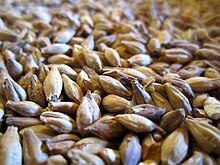
Back ملت Arabic Salīkla BAT-SMG Солад Byelorussian Солад BE-X-OLD Малц Bulgarian Malt Catalan Slad Czech Салат CV Malt Danish Malz German


Malt is any cereal grain that has been made to germinate by soaking in water and then stopped from germinating further by drying with hot air, a process known as "malting".[1][2][3][4] Malted grain is used to make beer, whisky, malted milk, malt vinegar, confections such as Maltesers and Whoppers, flavored drinks such as Horlicks, Ovaltine, and Milo, and some baked goods, such as malt loaf, bagels, and Rich Tea biscuits. Malted grain that has been ground into a coarse meal is known as "sweet meal".[5][6]
Malting grain develops the enzymes (α-amylase, β-amylase) required for modifying the grains' starches into various types of sugar, including monosaccharide glucose, disaccharide maltose, trisaccharide maltotriose, and higher sugars called maltodextrines. It also develops other enzymes, such as proteases, that break down the proteins in the grain into forms that can be used by yeast. The point at which the malting process is stopped affects the starch-to-enzyme ratio, and partly converted starch becomes fermentable sugars.
Malt also contains small amounts of other sugars, such as sucrose and fructose, which are not products of starch modification, but which are already in the grain. Further conversion to fermentable sugars is achieved during the mashing process.

Various cereals are malted, though barley is the most common. A high-protein form of malted barley is often a label-listed ingredient in blended flours typically used in the manufacture of yeast bread and other baked goods.[7] The term "malt" refers to several products of the process: the grains to which this process has been applied, for example, malted barley; the sugar, heavy in maltose, derived from such grains, such as the baker's malt used in various breakfast cereals; single malt whisky, often called simply "single malt"; or a product based on malted milk, similar to a malted milkshake (i.e. "malts").
- ^ "How to brew manually by John Palmer". Retrieved 6 October 2014.
- ^ "Quality Factors for Malting, Brewing and other End-uses". Oregon State University. Archived from the original on 4 October 2017. Retrieved 13 April 2007.
- ^ "What is malting?". Retrieved 6 October 2014.
- ^ Kirk-Othmer Food and Feed Technology. New York: Wiley-Interscience. 2007. pp. 116–120. ISBN 978-0-470-17448-7. Retrieved 7 July 2010.
- ^ Horace Kephart (1922). Our southern highlanders (eBook ed.). New York: The Macmillan Company. p. 134. Retrieved 10 April 2011.
The sprouted corn is then dried and ground into meal. This sweet meal is then made into a mush with boiling water, and is let stand two or three days.
- ^ Mills, Margaret H.; Claus, Peter J.; Diamond, Sarah (2003). South Asian folklore: an encyclopedia: Afghanistan, Bangladesh, India, Nepal, Pakistan, Sri Lanka. New York: Routledge. p. 5. ISBN 0-415-93919-4. Retrieved 10 April 2011.
The grain's own conversion of stored starch to sugar while sprouting ('malting') results in a sweet meal, which is then cooked for hours with water, oil, and additional wheat flour.
- ^ Evers, A. D.; Kent, N. (1994). Technology of cereals: an introduction for students of food science and agriculture. New York: Pergamon Press. p. 181. ISBN 0-08-040834-6. Retrieved 7 July 2010.
© MMXXIII Rich X Search. We shall prevail. All rights reserved. Rich X Search